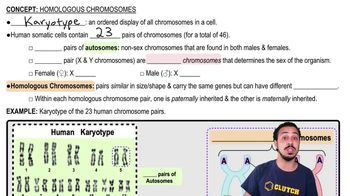Table of contents
- 1. Introduction to Biology2h 42m
- 2. Chemistry3h 40m
- 3. Water1h 26m
- 4. Biomolecules2h 23m
- 5. Cell Components2h 26m
- 6. The Membrane2h 31m
- 7. Energy and Metabolism2h 0m
- 8. Respiration2h 40m
- 9. Photosynthesis2h 49m
- 10. Cell Signaling59m
- 11. Cell Division2h 47m
- 12. Meiosis2h 0m
- 13. Mendelian Genetics4h 44m
- Introduction to Mendel's Experiments7m
- Genotype vs. Phenotype17m
- Punnett Squares13m
- Mendel's Experiments26m
- Mendel's Laws18m
- Monohybrid Crosses19m
- Test Crosses14m
- Dihybrid Crosses20m
- Punnett Square Probability26m
- Incomplete Dominance vs. Codominance20m
- Epistasis7m
- Non-Mendelian Genetics12m
- Pedigrees6m
- Autosomal Inheritance21m
- Sex-Linked Inheritance43m
- X-Inactivation9m
- 14. DNA Synthesis2h 27m
- 15. Gene Expression3h 20m
- 16. Regulation of Expression3h 31m
- Introduction to Regulation of Gene Expression13m
- Prokaryotic Gene Regulation via Operons27m
- The Lac Operon21m
- Glucose's Impact on Lac Operon25m
- The Trp Operon20m
- Review of the Lac Operon & Trp Operon11m
- Introduction to Eukaryotic Gene Regulation9m
- Eukaryotic Chromatin Modifications16m
- Eukaryotic Transcriptional Control22m
- Eukaryotic Post-Transcriptional Regulation28m
- Eukaryotic Post-Translational Regulation13m
- 17. Viruses37m
- 18. Biotechnology2h 58m
- 19. Genomics17m
- 20. Development1h 5m
- 21. Evolution3h 1m
- 22. Evolution of Populations3h 52m
- 23. Speciation1h 37m
- 24. History of Life on Earth2h 6m
- 25. Phylogeny2h 31m
- 26. Prokaryotes4h 59m
- 27. Protists1h 12m
- 28. Plants1h 22m
- 29. Fungi36m
- 30. Overview of Animals34m
- 31. Invertebrates1h 2m
- 32. Vertebrates50m
- 33. Plant Anatomy1h 3m
- 34. Vascular Plant Transport1h 2m
- 35. Soil37m
- 36. Plant Reproduction47m
- 37. Plant Sensation and Response1h 9m
- 38. Animal Form and Function1h 19m
- 39. Digestive System1h 10m
- 40. Circulatory System1h 57m
- 41. Immune System1h 12m
- 42. Osmoregulation and Excretion50m
- 43. Endocrine System1h 4m
- 44. Animal Reproduction1h 2m
- 45. Nervous System1h 55m
- 46. Sensory Systems46m
- 47. Muscle Systems23m
- 48. Ecology3h 11m
- Introduction to Ecology20m
- Biogeography14m
- Earth's Climate Patterns50m
- Introduction to Terrestrial Biomes10m
- Terrestrial Biomes: Near Equator13m
- Terrestrial Biomes: Temperate Regions10m
- Terrestrial Biomes: Northern Regions15m
- Introduction to Aquatic Biomes27m
- Freshwater Aquatic Biomes14m
- Marine Aquatic Biomes13m
- 49. Animal Behavior28m
- 50. Population Ecology3h 41m
- Introduction to Population Ecology28m
- Population Sampling Methods23m
- Life History12m
- Population Demography17m
- Factors Limiting Population Growth14m
- Introduction to Population Growth Models22m
- Linear Population Growth6m
- Exponential Population Growth29m
- Logistic Population Growth32m
- r/K Selection10m
- The Human Population22m
- 51. Community Ecology2h 46m
- Introduction to Community Ecology2m
- Introduction to Community Interactions9m
- Community Interactions: Competition (-/-)38m
- Community Interactions: Exploitation (+/-)23m
- Community Interactions: Mutualism (+/+) & Commensalism (+/0)9m
- Community Structure35m
- Community Dynamics26m
- Geographic Impact on Communities21m
- 52. Ecosystems2h 36m
- 53. Conservation Biology24m
12. Meiosis
Meiosis II
Problem 5`
Textbook Question
Select True or False for each statement.
Sister chromatids are homologous chromosomes.
Non-sister chromatids are found on two different homologs.
Crossing over occurs between sister chromatids.
A chiasma forms between two of the four molecules of double-stranded DNA on duplicated homologous chromosomes.
 Verified step by step guidance
Verified step by step guidance1
Understand the definition of sister chromatids: Sister chromatids are identical copies of a single chromosome, connected by a centromere. They are not homologous chromosomes, which are pairs of chromosomes (one from each parent) that have the same genes but may have different alleles.
Recognize the concept of non-sister chromatids: Non-sister chromatids refer to chromatids from homologous chromosomes. Since homologous chromosomes come from different parents, non-sister chromatids are indeed found on two different homologs.
Learn about crossing over: Crossing over is a process that occurs during meiosis where non-sister chromatids exchange genetic material. This does not occur between sister chromatids, as they are identical and do not need to exchange genetic material.
Understand the formation of a chiasma: A chiasma is the point where two non-sister chromatids exchange genetic material during crossing over. It involves two of the four chromatids present in a pair of homologous chromosomes, each consisting of double-stranded DNA.
Review the statements and apply the concepts: Use the definitions and explanations provided to determine the truth value of each statement based on your understanding of sister chromatids, non-sister chromatids, crossing over, and chiasma formation.
 Verified video answer for a similar problem:
Verified video answer for a similar problem:This video solution was recommended by our tutors as helpful for the problem above
Video duration:
1mPlay a video:
Was this helpful?
Key Concepts
Here are the essential concepts you must grasp in order to answer the question correctly.
Sister Chromatids vs. Homologous Chromosomes
Sister chromatids are identical copies of a single chromosome, connected by a centromere, formed during DNA replication. In contrast, homologous chromosomes are pairs of chromosomes, one from each parent, that are similar in shape, size, and genetic content but are not identical. Understanding the distinction is crucial for determining relationships between chromatids and chromosomes.
Recommended video:
Guided course

Homologous Chromosomes
Non-Sister Chromatids
Non-sister chromatids refer to chromatids from homologous chromosomes, which are not identical. They are important in genetic recombination processes like crossing over, where segments of DNA are exchanged between non-sister chromatids, leading to genetic diversity. Recognizing their role helps in understanding genetic variation mechanisms.
Recommended video:
Guided course

Eukaryotic Chromatin Modifications
Crossing Over and Chiasma Formation
Crossing over is a process during meiosis where non-sister chromatids exchange genetic material, resulting in genetic recombination. A chiasma is the visible point where this exchange occurs, typically between two of the four chromatids in a homologous pair. This process is essential for genetic diversity and proper segregation of chromosomes during meiosis.
Recommended video:
Guided course

Monohybrid Crosses
Related Videos
Related Practice






